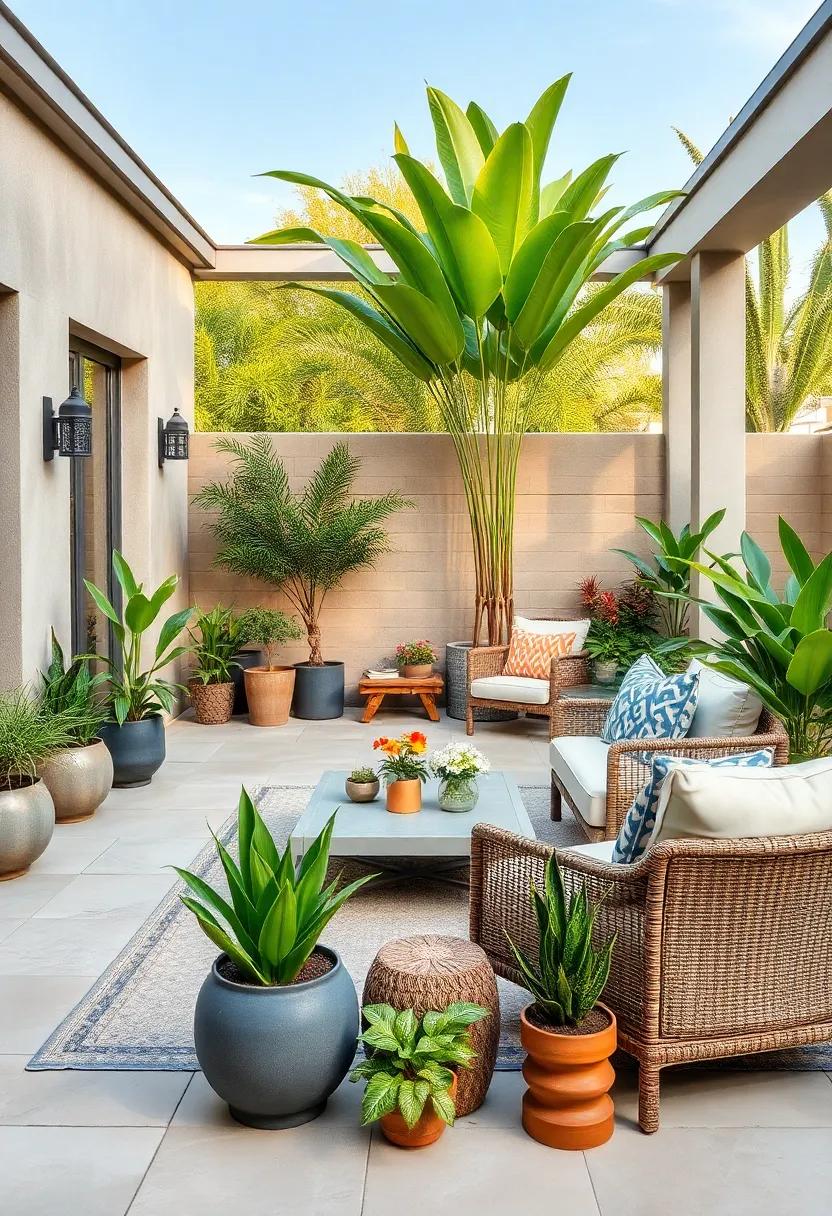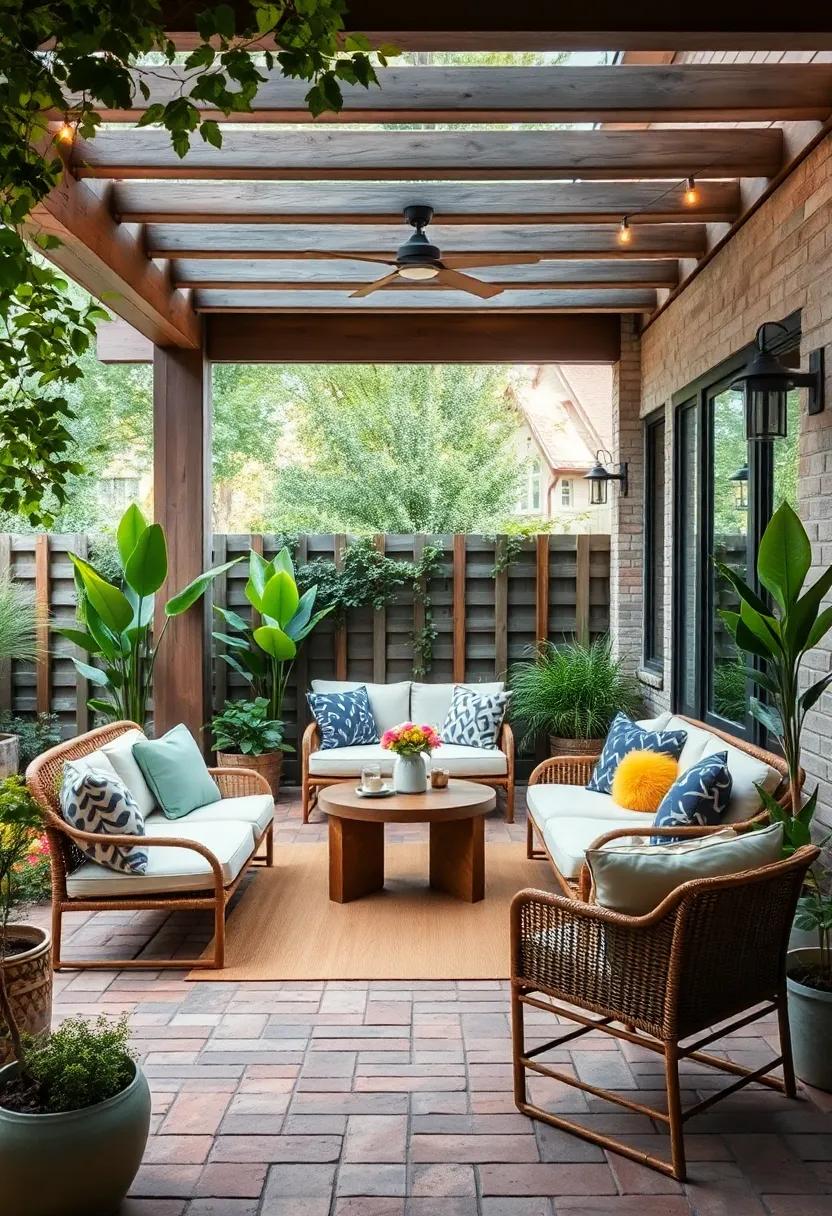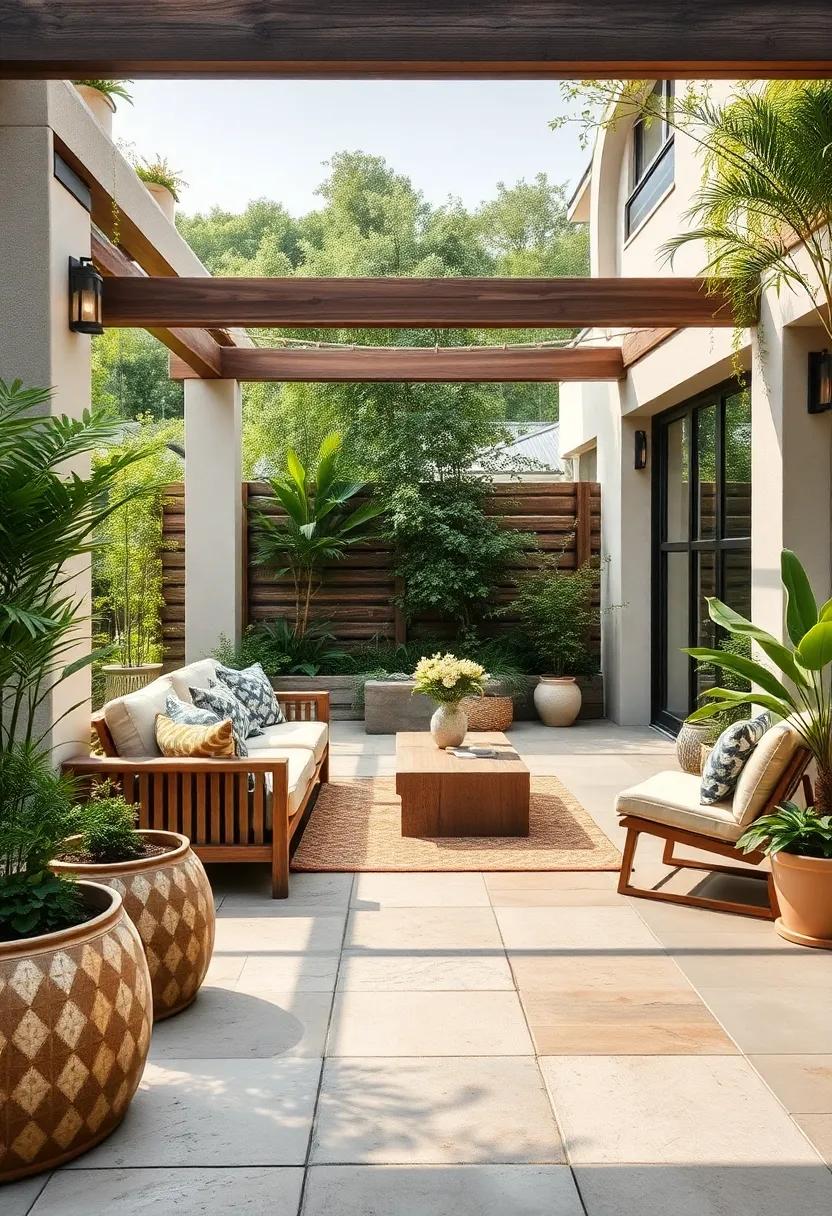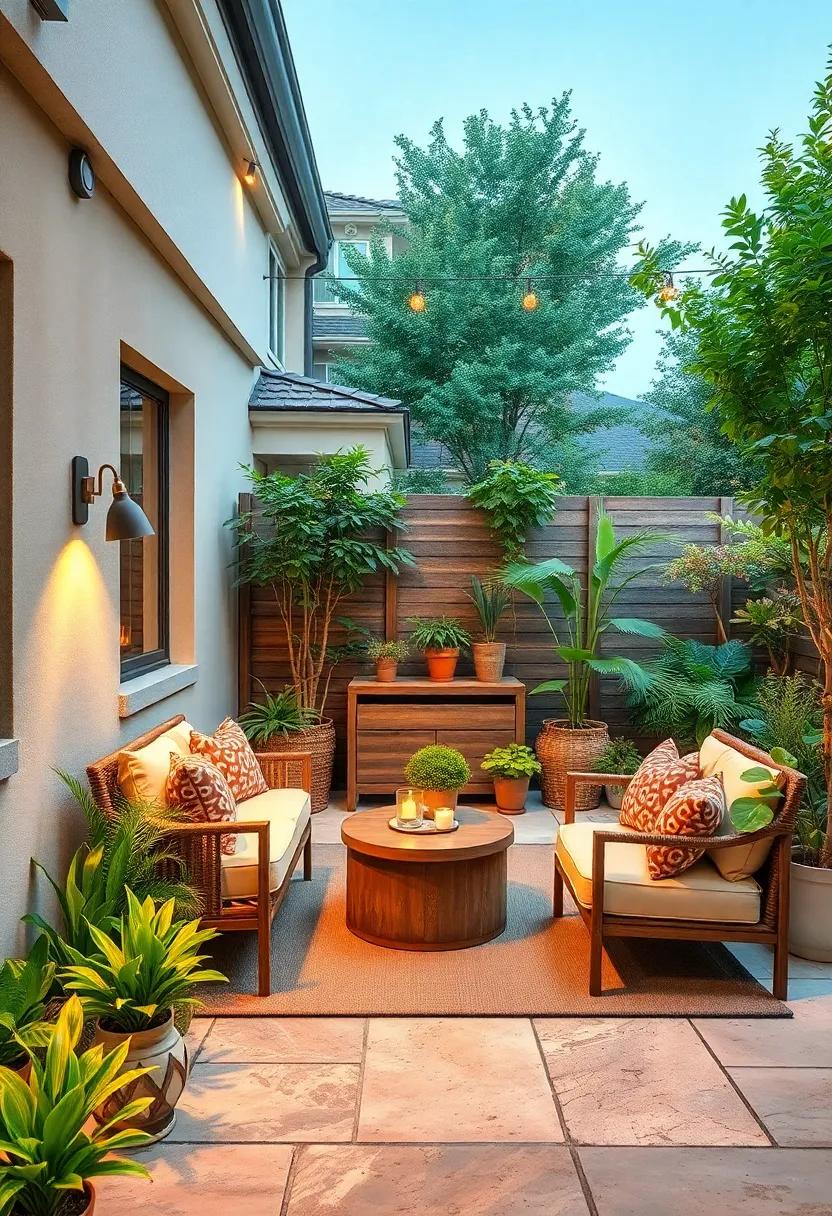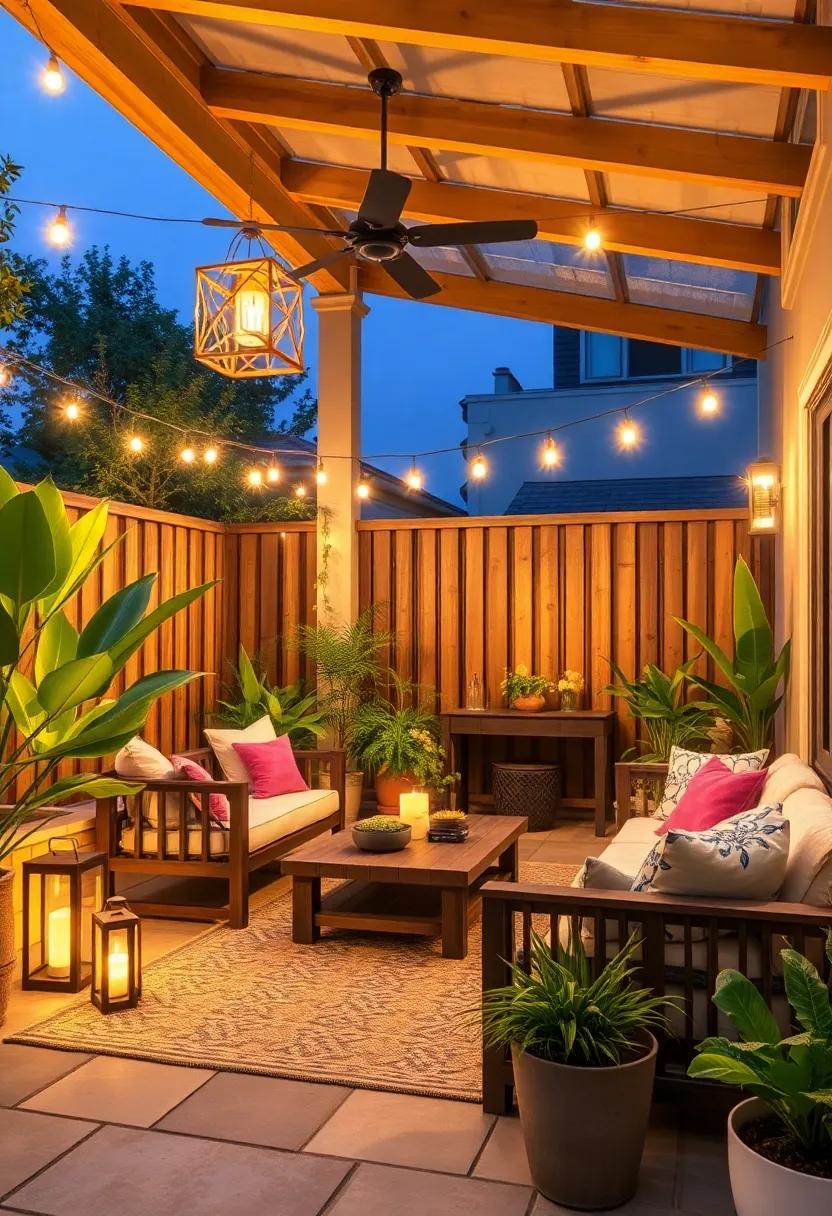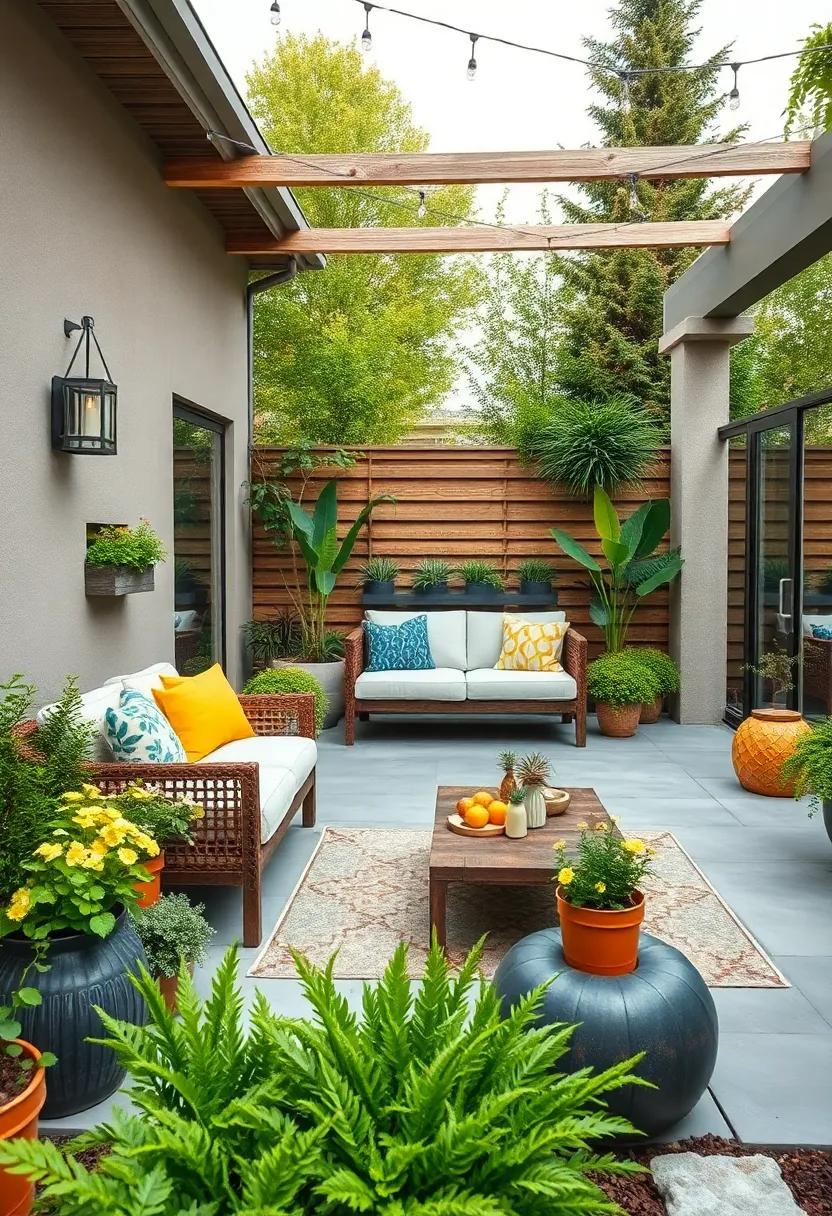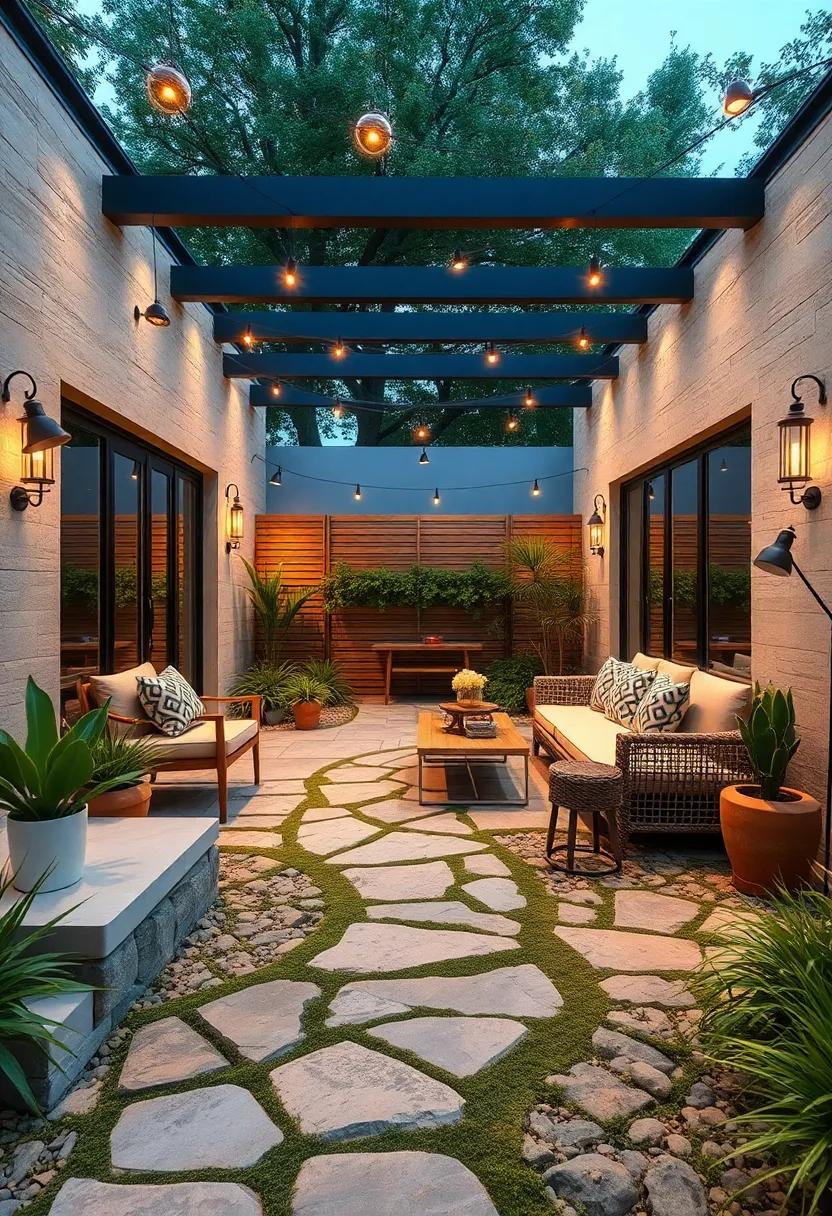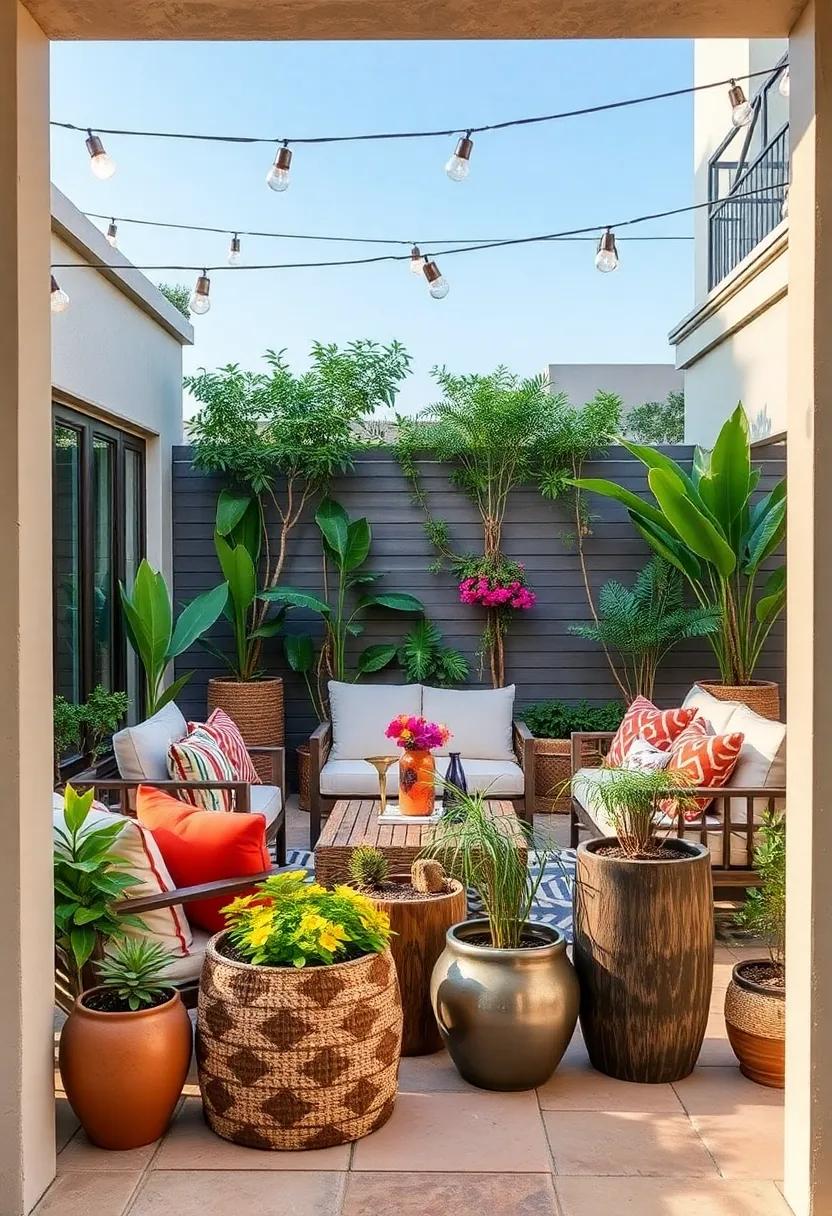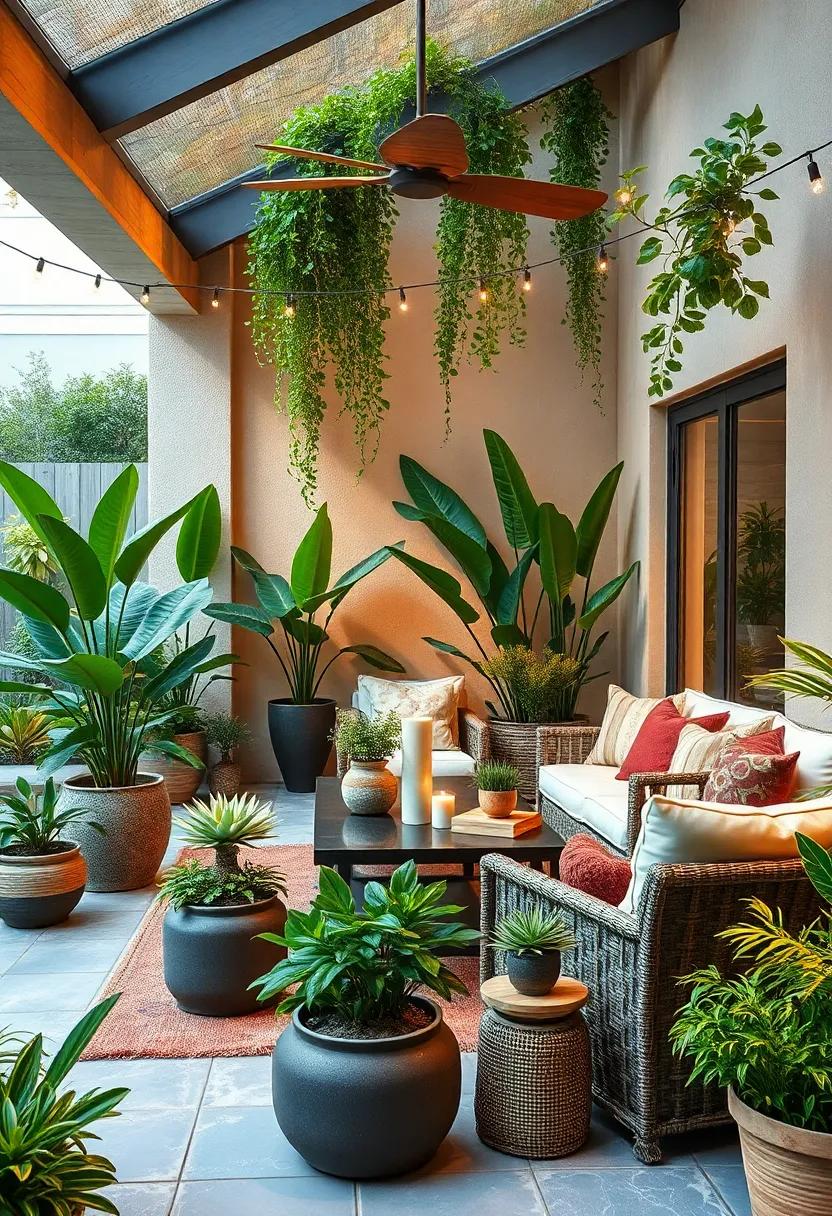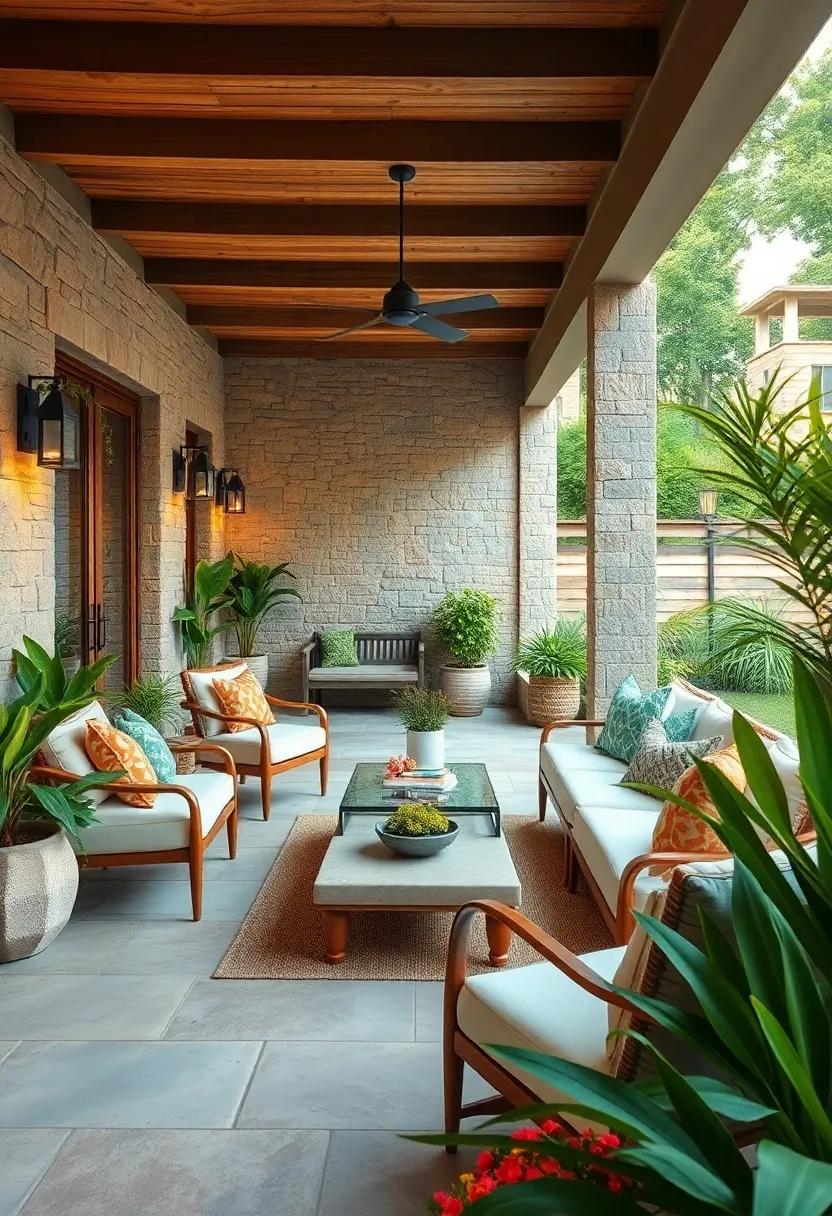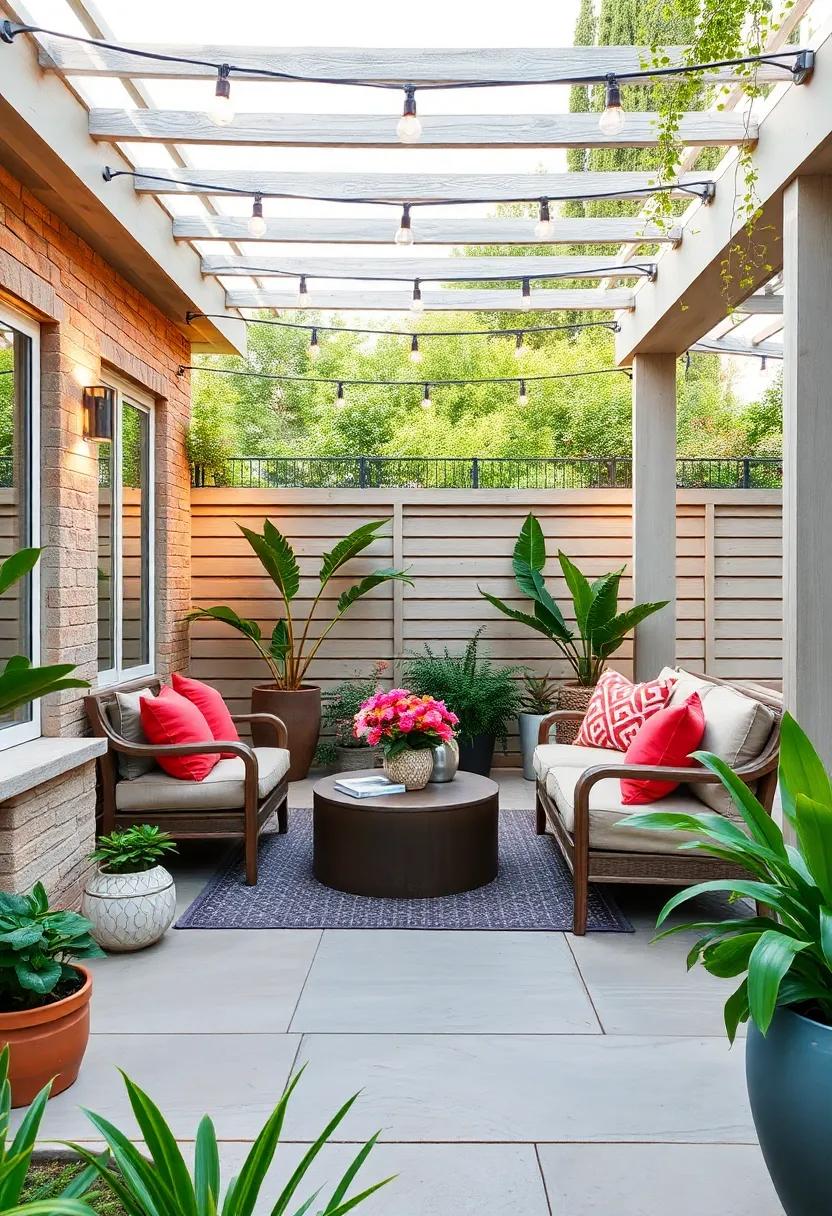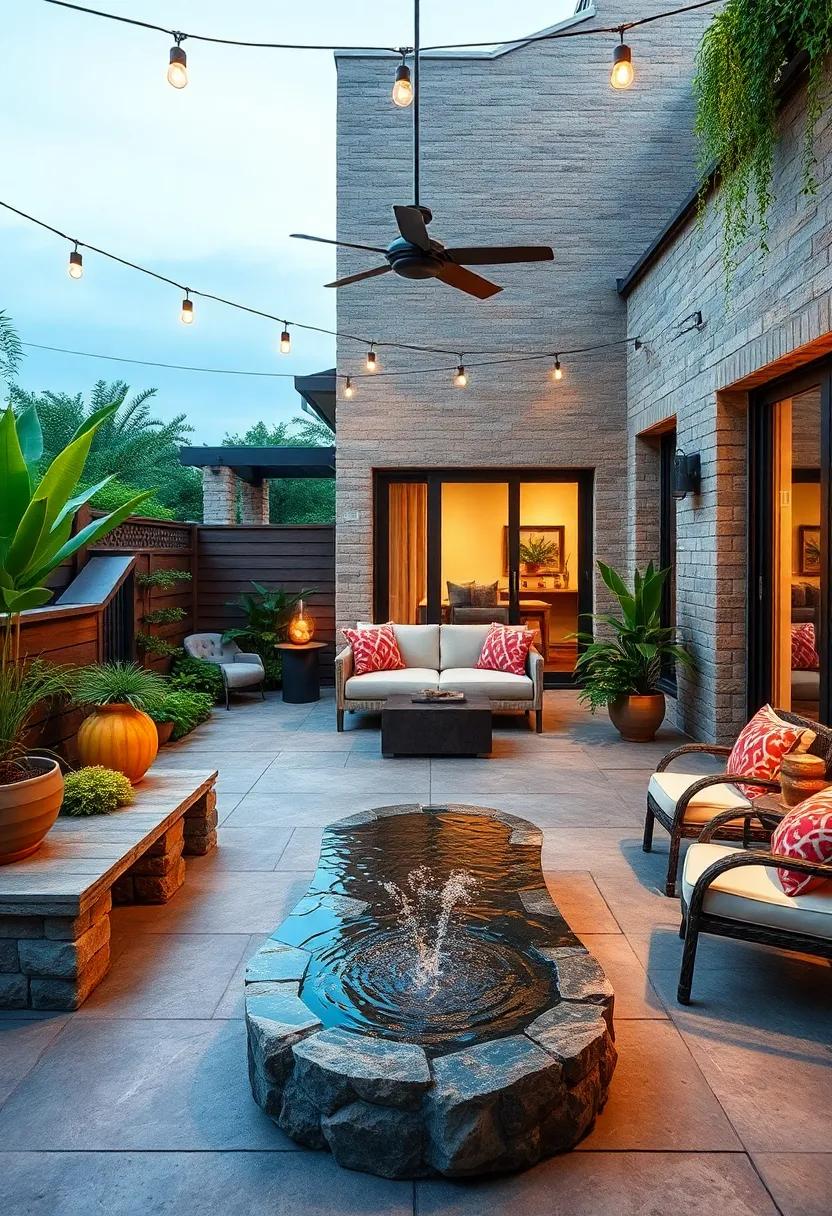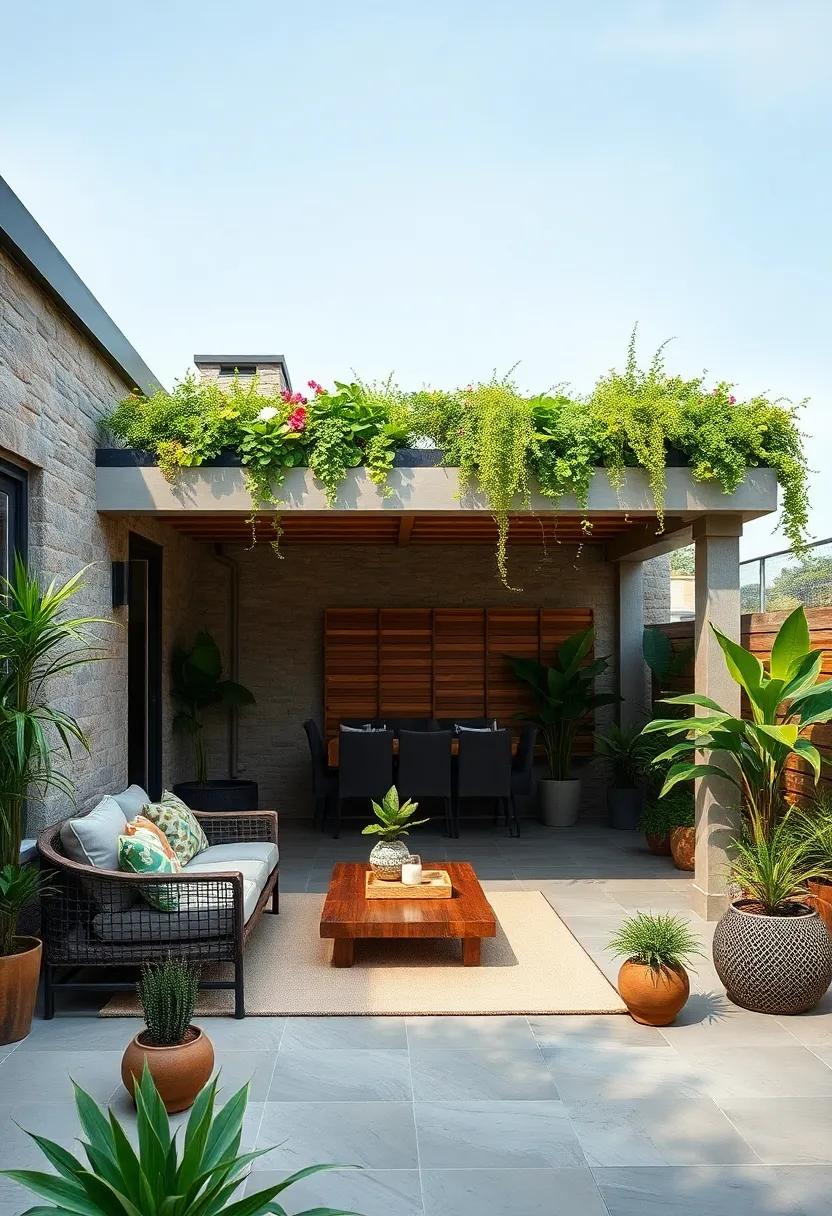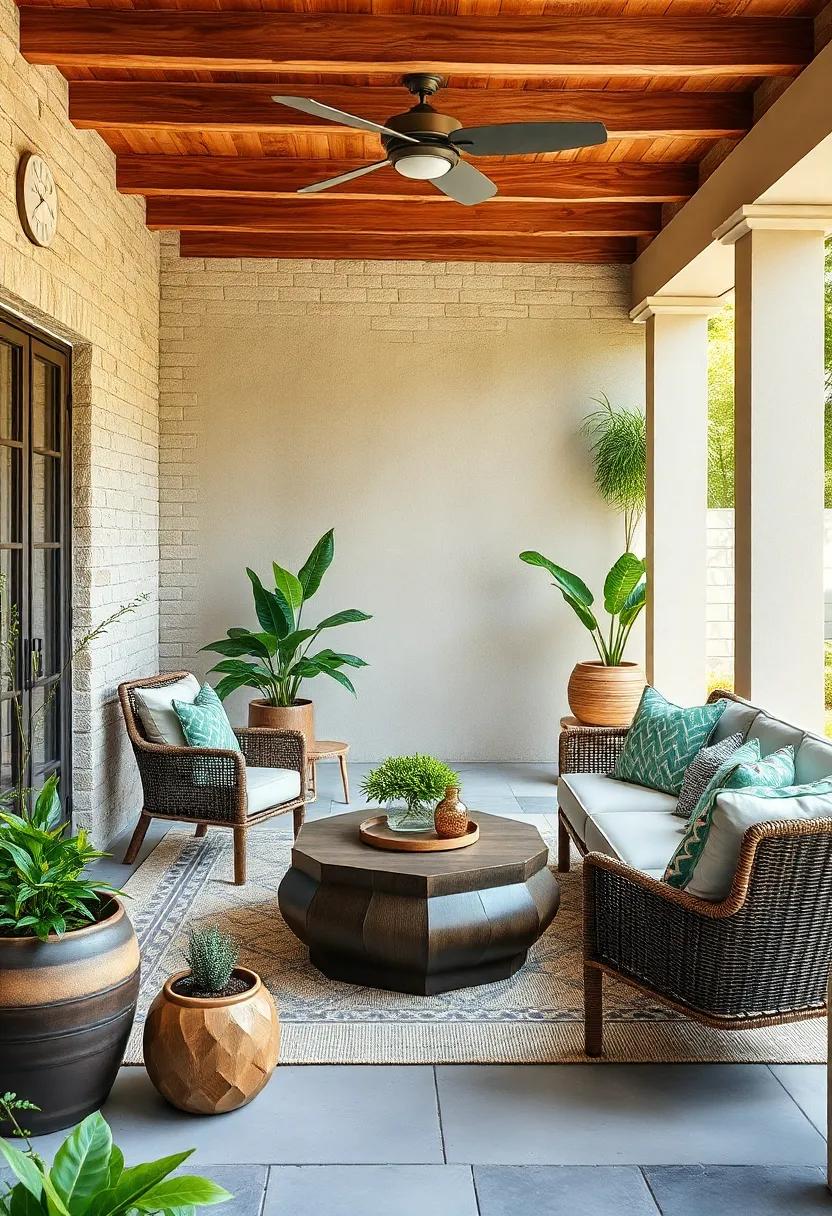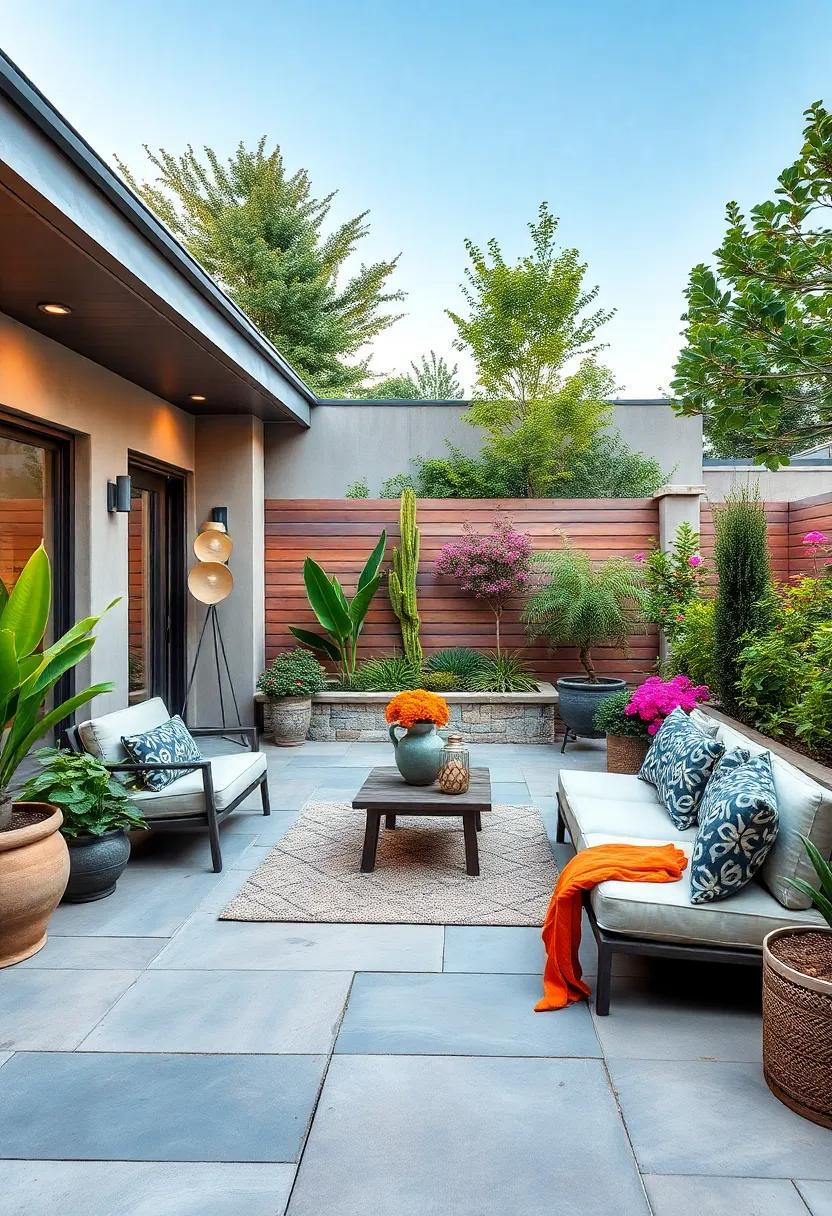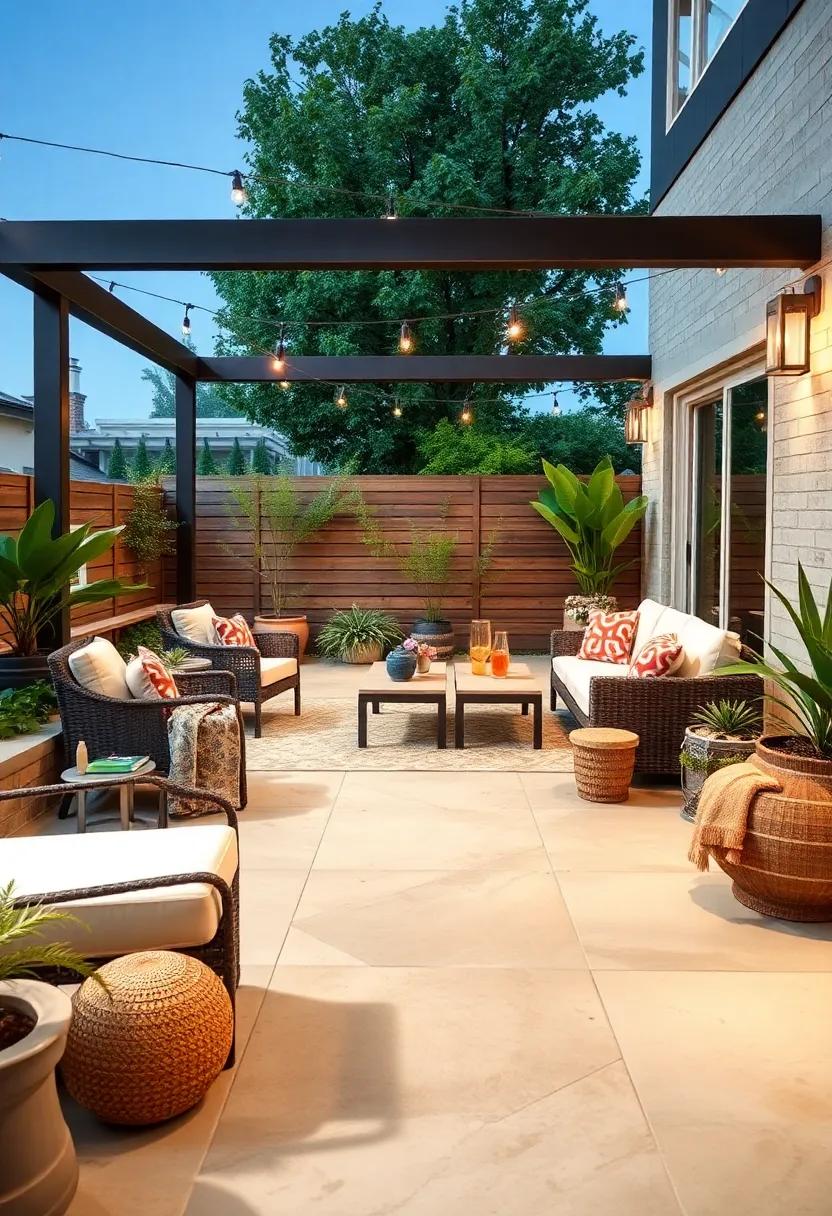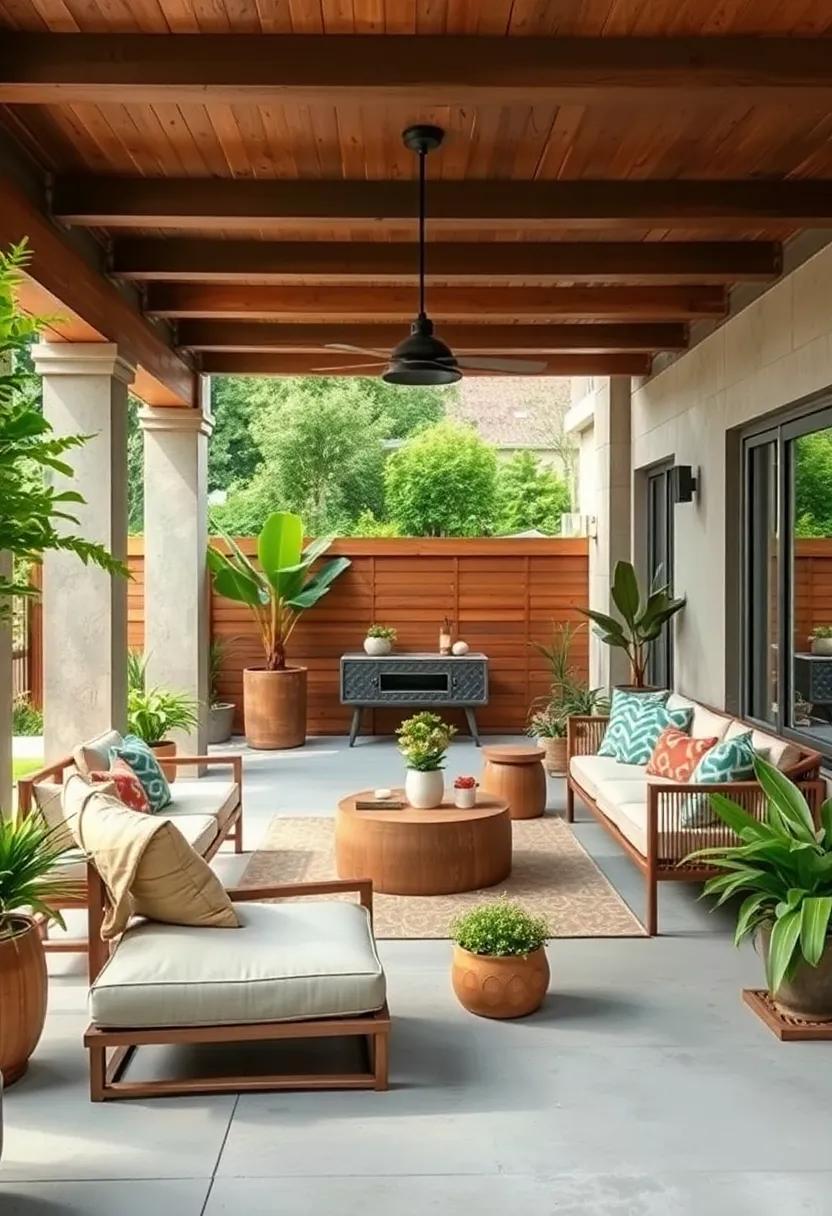
24 Inspiring Eco-Friendly Patio Design Ideas for a Sustainable Outdoor Oasis
Transforming your outdoor space into a serene adn sustainable sanctuary doesn’t have to be daunting. With the right inspiration, your patio can become a beautiful reflection of nature that also embodies eco-conscious design principles. In this listicle, we present 24 inspiring eco-friendly patio design ideas that will help you create an outdoor oasis that not only captivates the eye but also respects the environment. From the use of sustainable materials and native plants to innovative furniture solutions and recycling charm,each idea offers practical applications that you can easily integrate into your own space. Weather you’re looking to reduce your carbon footprint or simply love the idea of a greener lifestyle,this guide will empower you with actionable tips and creative concepts to harness the beauty of nature right in your backyard. Embrace sustainability and let your patio shine with these diverse and inspiring ideas!
Embrace Native Plants: Create a low-maintenance garden by incorporating native plants that thrive in your region,providing habitat for local wildlife and reducing water usage
Transform your outdoor space into a lush, eco-friendly retreat by choosing plants that are already adapted to your local climate. Native plants not only require less water and maintenance than exotic varieties, but they also create a vibrant ecosystem that supports birds, butterflies, and beneficial insects. To maximize your garden’s potential, consider incorporating a diverse range of colors, textures, and heights to create visual interest, while fostering a sanctuary for native wildlife. A few appealing options to include are:
- Wildflowers: Brighten your patio with seasonal blooms that attract pollinators.
- Grasses: Offer texture and movement with low-effort, drought-tolerant varieties.
- Shrubs: Provide essential shelter and nesting sites for birds, keeping your garden lively.
To aid in your plant selection, refer to a simple table outlining the benefits of incorporating native plants in your garden:
| Plant Type | Benefits |
|---|---|
| Perennials | Low maintenance, return year after year |
| Sedums | Drought tolerant with unique foliage |
| Vines | Provide vertical interest and habitat |
When designing your patio, think of groupings that celebrate the natural beauty of your region. Using native plants not only ensures your garden flourishes with minimal effort, but it also sends a powerful message about the importance of supporting local biodiversity. By creating a harmonious balance between beauty and sustainability, your outdoor oasis can become a cherished space for relaxation and a haven for wildlife.
Recycled Materials: Use reclaimed wood or repurposed bricks for patio flooring and furniture to add character while minimizing waste
Transforming your patio into an eco-friendly haven starts with the thoughtful selection of materials that tell a story while reducing your carbon footprint. Consider incorporating reclaimed wood into your flooring or furniture pieces. each plank carries its own unique history and character, resulting in a workspace that exudes rustic charm and warmth. Layering various types and finishes of wood not only adds visual interest but also showcases sustainability, as these materials significantly reduce the demand for new lumber. Pair this with furniture pieces made from repurposed bricks, which can create sturdy seating arrangements, striking flower beds, or even stylish fire pits. Old bricks add a touch of vintage elegance while promoting the idea of reusing materials that would otherwise end up in landfills.
To further enhance the sustainable ethos of your patio, consider designing with different wood grains and colors. Mixing & Matching Tips:
- Contrast: Light reclaimed wood with darker bricks for appealing visual depth.
- Texture: Incorporate rough-hewn wood alongside smooth-cut bricks for tactile diversity.
- Functionality:** Create multifunctional spaces such as a bench with storage or a table that transitions from dining to casual lounging.
In addition, you can enhance your outdoor space by using simple arrangements like:
| Material | Benefit |
|---|---|
| Reclaimed Wood | Unique character and history |
| Repurposed Bricks | Durability and vintage appeal |
Greenery Overhardscapes: Prioritize soft landscaping by opting for pavers and stones that allow for natural drainage and planting between them for a lush appearance
Embrace the beauty of nature by integrating soft landscaping elements into your outdoor space. Pavers and stones not only create an inviting and functional patio but also allow for natural drainage and the possibility of adding lush greenery between them. Imagine vibrant ground cover plants or delicate flowers peeking through the gaps,providing color and texture,while also contributing to the ecosystem. This technique enables rainwater to penetrate the ground, promoting more effective water management and reducing runoff, which is a key factor in sustainable design.
When selecting materials, choose permeable options that harmonize with your surroundings. Some excellent choices include:
- Porous Pavers: Allow water to drain through, reducing puddles and minimizing erosion.
- Natural Stone: Each piece is unique and blends beautifully with the environment while offering durability.
- Recycled Materials: Eco-friendly options like reclaimed bricks or tiles that bring character to your design.
Incorporating soft landscaping not only enhances aesthetics but also encourages biodiversity.Consider creating a harmonious balance by incorporating native plants that thrive with minimal care, promoting an eco-friendly approach to design without compromising beauty.
Vertical Gardens: Maximize space in small patios by installing vertical gardens that breathe life into your outdoor area and purify the air
Transform your small patio into a lush oasis by installing vertical gardens that not only optimize your space but also enhance the aesthetic appeal and air quality. Imagine cascading greens and vibrant blooms climbing up walls or trellises, creating a natural tapestry that invites tranquility. Just a few planters can make a dramatic difference, turning your otherwise underutilized areas into stunning focal points. You can choose from a variety of plants—
- Herbs: Perfect for a culinary touch.
- Succulents: Low-maintenance and stylish.
- Ferns: Ideal for a lush,tropical vibe.
- Flowers: Add color and fragrance.
Vertical gardens also contribute significantly to air purification, effectively filtering pollutants and releasing oxygen. By utilizing wall-mounted planters or pocket gardens, you can seamlessly integrate greenery into small spaces.Consider creating your vertical garden with recycled materials like wooden pallets or repurposed containers, reinforcing the eco-friendly theme of your patio. To maximize efficiency, here’s a simple comparison of different vertical gardening systems:
| Garden Type | Benefits | best Plants |
|---|---|---|
| Wall Planters | Space-saving, aesthetically pleasing | Herbs, Small Flowers |
| Trellis | Supports climbing plants | Vines, Tomatoes |
| Wall-Mounted Racks | Easy access for maintenance | Succulents, Ferns |
Composting Station: Integrate a chic composting station into your design to recycle kitchen scraps and create nutrient-rich soil for your plants
Transform your kitchen scraps into a powerhouse of nutrients for your garden with a thoughtfully designed composting station. Select a chic compost bin that complements your patio decor, using materials like sleek stainless steel or rustic wood to enhance your outdoor aesthetic. Incorporate a designated area with easy access, ensuring you can seamlessly toss in organic waste such as vegetable peels, coffee grounds, and lawn clippings. Consider adding a chic screen or decorative fencing to hide the compost from view, using plants or color to blend it into your patio’s overall look.
To make your composting process even more efficient, organize your station with labels for what can and cannot be composted. You can create a charming sign using reclaimed wood to designate your compost area, offering a touch of personality and guiding guests on how to contribute. include a small tool rack nearby for your composting essentials—like a pitchfork for turning the compost and a bucket for collecting scraps—ensuring a tidy and functional space. With this stylish setup, you’ll create an environmentally friendly oasis that not only looks good but also plays a critical role in sustainability.
Solar-Powered Lighting: Illuminate your patio sustainably with solar lanterns or string lights, creating a magical ambiance while saving on electricity
Transform your outdoor space with the enchanting glow of solar-powered lighting. Solar lanterns and string lights not only add a touch of whimsy to your patio but also harness the sun’s energy, making them a sustainable choice for eco-conscious homeowners. Set them up along pathways, drape them over pergolas, or cluster them around seating areas to create a cocoon of warmth and charm as the sun sets. With various styles available—from modern chic to rustic vintage—there is a perfect option for every aesthetic.
Incorporating solar lighting allows you to enjoy your outdoor oasis without the burden of rising electricity costs. Most solar lanterns and lights come equipped with automatic sensors that turn them on at dusk and off at dawn, ensuring effortless ambiance. Consider these benefits when choosing your solar lighting:
- Energy Efficiency: Reduces your carbon footprint by utilizing renewable energy.
- Variety: A wide range of designs and styles to complement your patio décor.
- Low Maintenance: Requires minimal upkeep and no wiring installations.
Rainwater Harvesting: Set up a rain barrel to collect and reuse water for your garden, reducing your reliance on municipal water
Transform your patio into a sustainable sanctuary by integrating a rainwater collection system. Setting up a rain barrel is a simple yet effective way to harness the natural resource that falls right from the sky. Place your barrel underneath a downspout to capture precipitation, ensuring that your garden can thrive even during drier spells. Benefits of this approach include:
- Conservation: Helps reduce your water bill while conserving municipal water.
- Plants Love It: Rainwater is free of chlorine and other chemicals, making it a healthier option for your garden.
- Low Maintenance: once installed, rain barrels require minimal upkeep.
To maximize your rain barrel’s efficiency, consider adding a few extras, such as a first-flush diverter to keep debris out of your collection system, or a spigot for easy access to water. Make sure to choose a barrel that complements your patio’s aesthetic—whether that’s a classic wood finish or a sleek modern design. Here’s a quick comparison to help you select the right barrel:
| Type of Barrel | Capacity (Gallons) | Cost |
|---|---|---|
| Plastic | 50-100 | $50-$100 |
| wood | 55-85 | $150-$250 |
| Metal | 50-120 | $100-$200 |
Sustainable Furniture: Choose outdoor furniture made from sustainable materials, such as bamboo or recycled plastics, for a stylish yet eco-conscious approach
When selecting outdoor furniture, opting for pieces crafted from sustainable materials not only enhances your patio’s aesthetic but also contributes positively to the environment. Bamboo, as an example, stands out as a remarkable option due to its rapid growth rate and minimal impact on ecosystems. Furniture made from bamboo frequently enough boasts an elegant, contemporary design while providing excellent durability and resistance to the elements.Similarly, recycled plastics present another excellent choice. These materials help divert waste from landfills and are engineered to withstand harsh weather, making them ideal for outdoor use. Stylish and adaptable, recycled plastic furniture can mimic traditional wood designs, giving you a chic outdoor setting without compromising eco-conscious values.
Incorporating sustainably sourced outdoor furniture into your design can be both impactful and trendy. Here are some appealing choices to consider:
- Bamboo lounge chairs: Lightweight and stylish, perfect for relaxing on sunny days.
- Recycled plastic dining sets: Available in a range of colors and styles, perfect for gatherings.
- Sustainable wood benches: Using reclaimed wood for a rustic touch while supporting sustainability.
- Eco-friendly cushions: Made from organic or recycled materials that add comfort without harming the planet.
By consciously choosing these sustainable furnishings, you can create a beautiful and environmentally friendly outdoor oasis that reflects your commitment to a greener lifestyle.
Bug-Friendly Features: Incorporate insect hotels or bee baths to support local pollinators while enriching your patio’s ecosystem
Enhancing your patio with native wildlife features can create a vibrant ecosystem right outside your door. Insect hotels serve as charming yet functional shelters for a variety of beneficial insects, including solitary bees, ladybugs, and butterflies. Consider constructing one from untreated wood, bamboo canes, or even hollow stems filled with natural materials to attract various pollinators. Placing your insect hotel in a sunny spot with proximity to flowering plants will maximize its allure, creating not only a haven for critters but also a visual centerpiece for your outdoor space.
Another delightful addition is a bee bath, which provides hydration for our buzzing friends without the risk of drowning.These can be simply designed from shallow dishes filled with water, pebbles, or marbles which allow bees to perch safely as they sip. You can jazz up your patio by opting for decorative or handmade ceramic bowls that blend seamlessly with your decor. By incorporating these features, you’re fostering biodiversity while creating an enchanting setting, making your patio not just a place for relaxation but a sanctuary for nature.
Fire Pit with Biofuel: Opt for a modern fire pit fueled by bioethanol or recycled materials for warmth and atmosphere without the environmental guilt
<img class="gimage_class" src="https://goodworksfurniture.com/wp-content/uploads/2025/05/ecofriendly-patio-design-ideas-fire.jpg" alt="Fire Pit with Biofuel: Opt for a modern fire pit fueled by bioethanol or recycled materials for warmth and atmosphere without the environmental guilt”>
Add a contemporary touch to your outdoor space with a fire pit powered by biofuel. These modern marvels use bioethanol, a renewable energy source derived from fermented plant materials, or recycled materials that minimize your environmental footprint. Not only do they produce clean and efficient flames, but they also create a cozy atmosphere ideal for gatherings under the stars. Imagine hosting friends around a dancing fire that offers both warmth and ambiance, all while knowing you’re making a sustainable choice.
When selecting a biofuel fire pit, consider the size and style that best suits your patio. Here are some key features to look for:
- Clean burning: Bioethanol produces low emissions, allowing you to enjoy a guilt-free fire.
- Portability: Many models are lightweight and can be moved to different settings in your garden or patio.
- Design Variety: From sleek modern lines to rustic charm, there’s a biofuel fire pit to match any aesthetic.
- Low Maintenance: With no ash or soot, keeping your fire pit clean requires minimal effort.
Upgrade your patio experience even further by opting for a fire pit that utilizes recycled materials. Not only does this choice promote sustainability, but it also allows for unique designs that tell a story. As an example, consider a fire pit crafted from repurposed metals or reclaimed bricks, giving your outdoor space a distinctive character while contributing to an eco-conscious lifestyle.
| Feature | Bioethanol fire Pit | Recycled Material Fire Pit |
|---|---|---|
| Fuel Type | Bioethanol | Various Recycled Materials |
| emissions | Low | Minimal |
| Design | Modern/Contemporary | Unique/Customizable |
Edible Landscaping: Design your patio with edible plants and herbs integrated into the landscape, adding beauty and functionality to your outdoor space
Transform your patio into a thriving oasis by integrating edible plants and herbs into your landscape design. By selecting a mix of vibrant edible flora, you can create a visually stunning environment that also serves a practical purpose. Consider using containers, vertical gardens, or raised beds to make the most of your space. Herbs like basil,cilantro,and mint can easily be planted in decorative pots,while edible flowers such as nasturtiums and pansies can add vibrant pops of color,inviting pollinators to your outdoor retreat. To enhance aesthetics, choose plants with diverse foliage colors and textures, varying from the deep, lush green of kale to the bright purple of eggplants.
To further design a multifunctional patio, think about incorporating fruit-bearing plants that can blend harmoniously with your decor. Striking fruit trees in dwarf varieties, such as apple or fig, can serve as focal points while providing shade and tasty produce. Create a herb spiral—an innovative, vertical garden structure that not only conserves space but also optimizes sunlight and water. This feature can become a stunning centerpiece, showcasing a variety of herbs including rosemary, thyme, and oregano. By thoughtfully layering and grouping these plants, you can ensure your patio looks lush and inviting while also being a source of fresh ingredients right at your doorstep.
Natural Stone Pathways: Create winding pathways using natural stones to enhance aesthetics while allowing water to permeate the ground naturally
Imagine a serene landscape where each step on your pathway invites you to explore the intricate beauty of nature. By using natural stones, you can create a charming and fluid pathway that blends seamlessly with your garden’s aesthetics. Laying stones in a winding design not only enhances visual interest but also mimics the organic curves found in nature,guiding the eye through your outdoor space. Choose from a variety of local stones—such as granite, slate, or river rocks—to craft a unique surface that reflects your personal style. The beauty of using these materials lies in their ability to enhance your space while promoting sustainability.
A notable advantage of natural stone pathways is their permeability, allowing rainwater to filter through the gaps and nourish the earth below. This helps minimize runoff and encourages biodiversity in your garden. Consider incorporating decorative ground cover plants in between the stones, creating a lush contrast that softens the pathway while playing a role in erosion control. As you design your pathway, think about adding features like low-impact lighting or natural elements such as pebbles and gravel for a multi-textural experience. Here’s a visual table to inspire you with some stone options:
| Stone Type | Texture | Color Variations | Best Use |
|---|---|---|---|
| Granite | Rough | Gray, Pink, Blue | Durable pathways |
| Slate | Smooth | Black, Green, Purple | Elegant walkways |
| River Rocks | Rounded | Natural Earth Tones | Natural drainage |
| Limestone | Textured | Beige, Yellow, Gray | rustic designs |
Upcycled Planters: Get creative with upcycling by turning old containers into quirky planters that showcase your style and serve a green purpose
Transforming everyday items into planters not only adds a unique flair to your patio but also contributes to a more sustainable environment. with a little creativity and a few tools, you can easily turn discarded containers into stunning, functional works of art. Here are some fantastic ideas to inspire your next project:
- Teacups and Mugs: Perfect for small succulents or herbs, these charming containers add a whimsical touch to your patio.
- Old Boots: Give your worn-out footwear a new lease on life by filling them with colorful flowers—ideal for a playful,rustic look.
- Wooden Crates: Stack or place these versatile planters in groups, letting vines and flowers spill out for a farmhouse chic vibe.
- Painted Cans: Repurpose tin cans by painting them in vibrant colors and patterns; use them for everything from kitchen herbs to wildflowers.
- Wine Bottles: Cut them in half or use them whole,these beautiful glass containers can create stunning vertical gardens.
Using upcycled materials allows you to infuse your personal style into your garden while minimizing waste. To showcase your creativity, consider mixing and matching different containers for an eclectic look. Here’s a quick guide to selecting the right plants based on the type of container:
| Container Type | Best Plant Choices |
|---|---|
| Teacups & mugs | Succulents, Herbs |
| Old Boots | Ferns, Small Flowers |
| Wooden Crates | Vines, Blooming Plants |
| Painted Cans | Herbs, Annuals |
| Wine Bottles | Trailing Plants, Air Plants |
Air-Purifying Plants: Add an assortment of air-purifying plants to your patio for cleaner air and a refreshing atmosphere that promotes relaxation
Transform your patio into a sanctuary for both the mind and body by incorporating a variety of air-purifying plants.Not only do these green companions enhance the aesthetic appeal of your outdoor space, but they also work tirelessly to improve the air quality around you, ensuring you can breathe deeply and relax completely. Consider adding plants like Spider Plants, renowned for their ability to filter out formaldehyde, or Peace Lilies, which not only purify the air but also add a touch of elegance with their delicate white blooms. Other excellent choices include Boston Ferns, Snake Plants, and Aloe Vera. Each of these species brings its unique charm and air-cleaning properties.
To create a vibrant and refreshing atmosphere, arrange these plants in stylish pots that complement your patio decor. Mixing textures and colors can invigorate your space; consider using terracotta pots for a rustic look or sleek, modern containers for a contemporary touch. An ideal approach is to group plants with varying heights and leaf shapes, which can add a dynamic layer to your patio design. You can even incorporate wall-mounted planters or vertical gardens to save space while maximizing greenery. Below is a simple table summarizing some popular air-purifying plants and their benefits:
| plant Name | Air-Purifying Benefits |
|---|---|
| Spider Plant | Reduces formaldehyde and xylene |
| Peace Lily | Filters ammonia, benzene, and acetone |
| boston Fern | Excellent for humidifying air and removing pollutants |
| Snake Plant | Converts CO2 to oxygen at night |
| Aloe Vera | Removes formaldehyde and improves humidity |
Eco-Friendly Fabrics: Choose cushions, pillows, and outdoor fabrics made from organic or recycled materials to bring comfort while keeping the environment in mind
Elevate your outdoor space with cushions and pillows crafted from eco-friendly fabrics. By selecting items made from organic or recycled materials, you create a serene atmosphere while making a conscious choice for the planet. Options like organic cotton, which is grown without harmful pesticides, or recycled polyester, made from plastic bottles, serve as excellent alternatives to conventional materials. These fabrics not only add comfort and style to your patio but also ensure that your furnishings support sustainable practices.
When choosing your cushions and pillows, consider the following fabrics that harmonize with your eco-conscious goals:
- Hemp – Durable and biodegradable, hemp fabric is a powerhouse of sustainability.
- Tencel – Made from eucalyptus trees, this fabric is not only soft but also produced in a closed-loop system, minimizing waste.
- Recycled Canvas – Ideal for outdoor use, this rugged fabric withstands the elements while reducing landfill waste.
- Organic Linen - Breathable and luxurious, linen requires less water to produce compared to conventional cotton.
Creating a table to showcase the benefits of these eco-friendly fabric options can guide your selections:
| Fabric | Benefits | Aesthetic |
|---|---|---|
| Hemp | Biodegradable, low water usage | Earthy and rustic |
| Tencel | Soft, reduced waste production | Sleek and elegant |
| Recycled Canvas | Durable, reduces landfill waste | Casual and versatile |
| Organic Linen | Less water required, breathable | Chic and fresh |
Eco-Conscious Decor: Decorate your patio with artwork made from sustainable materials, highlighting creativity while advocating for eco-friendly practices
Transform your patio into a haven of sustainability with eco-conscious artwork that not only beautifies your space but also promotes responsible living. Consider using pieces crafted from recycled materials, such as glass shards, reclaimed wood, or upcycled metals, which turn waste into vibrant sculptures or wall hangings. This innovative approach not only adds a unique flair to your outdoor area but also sparks conversations about environmental impact and creativity. Incorporating planters made from biodegradable materials or paintings on canvas made from organic fibers further aligns your patio with a commitment to sustainability while showcasing local artisans.
Additionally, highlight your patio with nature-inspired installations. Wind chimes made from recycled aluminum or bird feeders fashioned from reclaimed plastics can create an enchanting environment, inviting the sounds and sights of nature closer. Consider displaying wall art painted with natural dyes or even murals that blend seamlessly with the surrounding flora. You can also include upcycled furniture pieces adorned with outdoor-friendly, eco-dyes, ensuring every element in your decor resonates with sustainable practices. by choosing these creative avenues, you can cultivate a patio that is not only aesthetically pleasing but also a testament to eco-friendly living.
nature-Inspired Color Palette: Opt for earthy tones in your decor to foster a calming atmosphere that connects your patio with the surrounding environment
Transform your patio into a serene retreat by embracing the serene hues found in nature. Opt for earthy tones like rich browns, soft greens, and muted terracotta to create a harmonious blend with the environment. These colors not only promote a calming atmosphere but also enhance the natural beauty surrounding your space. to further reinforce this connection, consider incorporating materials that reflect these shades, such as wooden furniture, clay pots, and natural stone tiles. By using sustainable materials with organic textures, your patio can echo the simplicity and elegance of the great outdoors.
To bring your earthy palette to life, accessorize with soft textiles and greenery that complement your chosen tones. Try incorporating elements like:
- Cozy throw pillows in muted foliage shades
- Natural fiber rugs to add warmth and texture
- Live plants in various shades of green
These choices not only enhance the visual appeal of your patio but also foster a sense of tranquility, making it the perfect spot for relaxation and rejuvenation. To showcase your connection to nature,think about using a color wheel for selection or crafting a quick reference table to keep your design theme cohesive.
| Color | Hex Code |
|---|---|
| Forest Green | #228B22 |
| Sandy Beige | #F4A460 |
| Rustic Red | #8B0000 |
| Clay Orange | #D95F0E |
Drip Irrigation Systems: Install a drip irrigation system for efficient watering, conserving water while ensuring your plants receive the moisture they need
Transform your patio into a sustainable haven by integrating a drip irrigation system that delivers water directly to the roots of your plants. This method minimizes evaporation and runoff, allowing you to conserve precious water while ensuring that your greenery thrives. With a variety of components like drippers,hoses,and filters,you can customize your system to meet the specific watering needs of your garden layout. Plus, it adds a modern touch to your outdoor space, promoting a seamless blend of style and efficiency.
Consider the following benefits of implementing such a system on your patio:
- Targeted Watering: Water is delivered precisely where it’s needed.
- Reduced Weeds: By watering only your plants, you decrease the chance of weed growth.
- Less Labour-Intensive: Set it and forget it! Automation allows for less manual work.
- Eco-Friendly: Greatly reduces water waste, contributing to environmental conservation.
To give you an idea of how to set up your system,consider the following comparison table of materials you might choose:
| Material | Benefits | Typical Use |
|---|---|---|
| plastic Tubing | Durable and flexible | Main water supply line |
| Tape Drippers | Even water distribution | Row crops and garden beds |
| Emitters | Adjustable flow rates | Individual plants |
| Filtration System | Prevents clogging | All systems |
Solar Water Features: Introduce a solar-powered water feature for a soothing sound that enhances relaxation and attracts wildlife to your outdoor space
Transform your outdoor sanctuary into a serene retreat with a solar-powered water feature that not only adds visual appeal but also promotes tranquility. The gentle sounds of flowing water can create a calming atmosphere, perfect for unwinding after a long day. Using solar energy, these features operate sustainably, ensuring that your eco-friendly efforts are fully realized. Consider options such as:
- Solar fountains – These can come in a variety of styles, from classical sculptures to modern designs.
- Pondless waterfalls – A beautiful way to enjoy the sight and sound of cascading water without the maintenance of a pond.
- Solar birdbaths – Attract feathered friends while providing them with a refreshing water source.
In addition to creating a peaceful ambiance, solar water features can attract a variety of wildlife, adding to the biodiversity of your outdoor space. The soft sounds of water can draw in delightful visitors such as birds, butterflies, and beneficial insects. To maximize the ecological friendliness of your water feature, consider the following:
- Native plants – Use landscaping around your water feature that supports local wildlife and requires less maintenance.
- Natural filters – Create a filtration system using stones and plants that can keep the water clean while encouraging natural habitats.
- Placement – Position your feature to receive plenty of sunlight during the day, ensuring optimal solar efficiency.
DIY Green Roof: If possible, create a green roof on your patio overhang to promote insulation and support biodiversity while providing a unique design element
Transform your patio overhang into a lush retreat by installing a green roof, an innovative way to enhance insulation while promoting biodiversity. This environmentally friendly feature not only helps regulate temperature but also serves as a stunning visual element. Imagine stepping outside to a vibrant carpet of native plants, contributing positively to your local ecosystem. Consider using a mixture of sedums, wildflowers, and grasses that are well-adapted to your climate, ensuring a low-maintenance yet thriving green space.
To ensure the success of your green roof, an appropriate waterproofing and drainage system is essential.Here’s a simple checklist to guide your project:
- Waterproof membrane: protects your structure from water damage.
- Drainage layer: Facilitates excess water runoff, preventing plant roots from drowning.
- Growing medium: Use lightweight soil mixes that retain moisture yet allow healthy drainage.
- Plant selection: Opt for hardy, drought-resistant varieties that thrive in your region.
This green space not only catches the eye but can also be turned into a small haven for birds and pollinators,enriching your outdoor experience. By skillfully integrating plants into your patio’s architecture, you’ll create a living artwork that enhances your home’s aesthetic while making a significant ecological impact.
Natural Shade Solutions: use pergolas, shade sails, or strategically placed trees to provide relief from the sun without relying on air conditioning
Embrace the art of shade with stylish and functional solutions that not only elevate your patio but also promote eco-friendliness. Pergolas are an excellent choice for creating a cooling canopy of vines and climbing plants. These structures allow dappled sunlight to filter through while providing a comfortable space to relax. Additionally, you can accentuate the beauty of a pergola with dangling fairy lights or fabric curtains for added privacy and charm. Another popular option is shade sails, which are an attractive and modern way to block harsh sunlight. These versatile and colorful canopies can be hung in various configurations to enhance your outdoor space while providing essential UV protection.
If you prefer a natural approach, strategically placing trees around your patio can offer both shade and beauty. Consider planting deciduous trees that provide cooling shade in summer and allow sunlight to warm your patio in winter after shedding their leaves.While you might think about types like maple or oak, research local native species that suit your climate to ensure optimal growth and sustainability. For a truly unique touch, install a living wall of climbing plants, such as ivy or clematis, which can function as a natural green screen combined with the benefits of shade. Together, these options create a tranquil outdoor oasis that seamlessly blends with the environment while minimizing the need for air conditioning.
Eco-Friendly Paint: choose VOC-free or non-toxic paints for any wooden structures or furniture to maintain air quality and environmental health
opting for paints that are free from volatile organic compounds (vocs) and other harmful chemicals is essential in nurturing a healthy environment, especially in outdoor settings where natural ventilation is abundant. Embracing eco-friendly paint not only protects your health but also enhances the longevity of your wooden structures and furniture. Look for brands that proudly display their non-toxic certifications, ensuring that what you apply is safe for both your family and the planet. Some great options are milk paint, chalk paint, and natural oil finishes, which come in a variety of attractive colors while leaving a minimal environmental footprint.
When it comes to applying this sustainable choice, there are several practical tips to keep in mind. first, conduct any painting jobs on calm days to prevent the wind from carrying fumes into your space.Additionally, make sure to allow sufficient drying time before using the area to ensure that any lingering odors dissipate completely. To inspire you even further, consider creating a DIY paint project that transforms old wooden furniture into statement pieces for your patio, allowing you to personalize your outdoor space while keeping it eco-friendly. Here are some recommended non-toxic paint brands:
| brand | Type | Features |
|---|---|---|
| Milk paint Co. | Milk Paint | Non-toxic,biodegradable,and customizable |
| Eco Paint | Latex Paint | Zero-VOC,durable,and easy cleanup |
| CeCe Caldwell’s | Chalk and Clay Paint | No toxic fumes,with a matte finish |
| AFM Safecoat | Interior/Exterior paint | Non-toxic with a focus on air quality |
Bio-Diversity Gardens: Design sections of your patio to encourage biodiversity by planting a variety of species,benefiting pollinators and creating visual interest
Transform your patio into a vibrant bio-diversity haven by designing distinct sections that cater to a variety of plant species. Choose an assortment of native plants,flowers,and herbs to create a dynamic ecosystem that attracts and supports essential pollinators such as bees,butterflies,and hummingbirds. consider incorporating a wildflower patch, a herb garden, and nectar-rich plants to ensure a steady supply of food and habitat for these vital creatures. each section can be visually enhanced with natural stone borders or raised beds, providing structure while also improving drainage and plant health.
To further promote biodiversity, think about adding features like water sources, such as a small pond or birdbath, and shelters for beneficial insects and birds. Integrate different planting heights and textures to create layers in your garden, enhancing its aesthetic appeal. use a mix of evergreen shrubs,deciduous trees,and colorful perennials to keep your patio lively throughout the seasons. Here’s a simple table to visualize ideal biodiversity plants:
| Plant Type | Benefits |
|---|---|
| lavender | Attracts bees and provides fragrance |
| Echinacea | Supports butterflies and provides seeds for birds |
| Bee Balm | Ideal nectar source for pollinators |
| mint | Repels certain pests and enriching soil |
Flexible Layouts: Design your patio with movable furniture or modular components for maximum versatility, making it easy to adapt to various activities and gatherings sustainably
Transform your outdoor space into an adaptable haven by incorporating movable furniture and modular components.Imagine hosting a cozy dinner party one evening, then rearranging everything for a lively game night the next. Opt for foldable chairs, stackable tables, or even modular sofas that can shift from a relaxed setup to a more formal arrangement. This adaptability not only maximizes the functionality of your patio but also contributes to a sustainable lifestyle by reducing the need for multiple pieces of furniture.When selecting items, look for those made from recycled materials or sourced from local artisans, further connecting your space with eco-friendly practices.
to enhance the versatility of your patio, consider design elements that allow for easy reconfiguration. lighting solutions, such as string lights or solar-powered lanterns, can create the perfect ambiance for both intimate gatherings and larger, vibrant celebrations. Pair these with movable planters filled with native plants, offering greenery that can be rearranged for optimal sun exposure or aesthetic balance. You can even design your space with modular outdoor rugs that can be moved or layered easily, adapting the style to match your activities. With these thoughtful choices, your patio will not only reflect your personal taste but also embrace an adaptable and eco-conscious ethos.
Concluding Remarks
As we wrap up our exploration of these 24 captivating eco-friendly patio design ideas, we hope you feel inspired to create your own sustainable outdoor oasis. Each concept not only invites you to enjoy nature but also embodies the essence of thoughtful living. From repurposed materials to native planting and energy-efficient lighting, these designs harmonize beauty and environmental consciousness.
By incorporating even a few of these elements, you can transform your patio into a serene retreat that reflects your commitment to sustainability. Remember, every small step counts in our journey toward a greener planet. So gather your tools, ignite your creativity, and start crafting an outdoor space that is as gentle on the earth as it is delightful to the senses. Here’s to creating harmony between your home and nature—one patio at a time!
As an Amazon Associate I earn from qualifying purchases.
